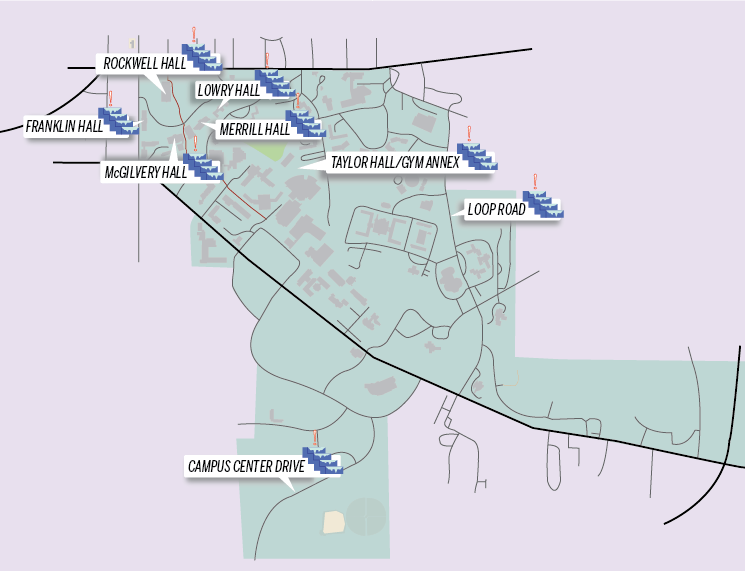Specific areas on campus more dangerous during winter weather
January 14, 2015
North campus and areas that get the most shade tend to present a greater risk for encountering black ice — a transparent coating of ice that covers many of the surfaces on campus.
Kent State’s University Facilities Management clears and treats the sidewalks and surrounding roads of campus, including Campus Center Drive and Loop Road. Grounds Manager Heather White said both roads, as well as areas on front campus, are challenging when it comes to clearing them off and keeping the pavement wet to avoid freezing. White said the greatest challenges are on the north side of buildings.
Sidewalks and stairs directly beside the north side of buildings are hidden from direct sunlight, making it easier for these areas to freeze, said Roy Christian, director of operations at the University Facilities Management.
Buildings near front campus also tend to be more hazardous when it comes to ice conditions because many staircases are located in this region of campus. Many of these staircases are also in the shade of the buildings, lowering the temperature and causing them to freeze more easily than other areas.
Some of these areas include Franklin Hall, Lowry Hall, Merrill Hall, McGilvrey Hall and the sidewalk between Taylor Hall and the M.A.C. Center Annex.
“There are so many steps coming off those buildings and shade,” White said.
Though the sidewalks looked fairly icy after the Sunday night snow, White said the worst of the icy conditions would come later in the winter season.
She said the warmer temperatures during the day in late February or early March can be above freezing, melting the snow. Then the colder temperatures at night cause the snow to refreeze as ice over sidewalks.
“When we start getting these crazy temperature swings, our snow piles start melting,” Christian said.
When these large snow piles melt, Christian said if there is not enough draining space, the water could pool and cause black ice on sidewalks and in parking lots.
To minimize black ice and other winter weather-related conditions, salt barrels and boxes have been placed throughout campus near buildings and major intersections.
White said many students don’t recognize the barrels as salt containers.
“I do know that at Prentice, it seems like they use it as a trash barrel,” she said.
University Facilities Management collaborates with Parking Services when plowing parking lots and deciding where to place removed snow. The two departments work as a team to choose snow removal locations and spot salt problem areas.
Parking Services Manager Larry Emling said he finds problems with the lots next to White Hall and the commuter lot next to the Music and Speech Building.
“Sometimes if the building is on the south side of the parking lot, it can affect how it melts compared to other lots that are more open,” Emling said.
When it comes to black ice in parking lots, exercising caution is the best way to prepare.
“You almost have to prepare to expect that it’s going to be icy,” Emling said. “We do our best, but you’re not going to get every spot. It’s just not possible.”
Students can also call the University Facilities Management office to report any hazardous or slippery conditions on campus at 330-672-2345.
“Let us know if they encounter it,” White said. “Tweeting about it won’t make it to our desk.”
Contact Samantha Ickes at [email protected]

























